CHAPTER ONE
IntroductionCHAPTER ONE
Introduction
Did you know that WordPress is now used to power 42.5% of the world’s websites (at the time of writing)? It’s an astonishing figure and one that continues to rise annually with no sign of slowing down. As such a dominant player in the world of CMS solutions (Content Management Systems), it’s perhaps no surprise to find that the number WordPress websites running WooCommerce is also seriously sizeable. In fact, when you look at the top Million sites in the world, 25% of them are running WooCommerce
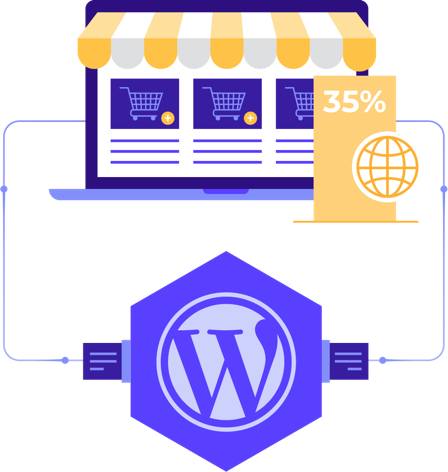
The explosion seen in online shopping shows no sign of slowing down which is great news for anyone running an eCommerce store. On the flip side however, it does mean that the level of competition between stores is ever increasing. Optimizing your WooCommerce store has got to be a top priority to ensure sales continue to roll in. After all, if a WooCommerce store that turns over $100,000 in a year implements changes that increase sales by just 5%, that would mean an additional $5,000 in revenue.
In this white paper we are going to look at some key factors that are critical to the success of a WooCommerce store and along the way explore how your WooCommerce store can be best optimized for sales performance
CHAPTER TWO
The unstoppable rise of WooCommerceCHAPTER TWO
The unstoppable rise of WooCommerce
Do you shop online? Probably. With sales expected to top an eye watering $4.5 trillion by 2021, it seems everyone is now buying online. And the great news is that setting up an eCommerce store has never been easier or cheaper, thanks to WooCommerce.
WooCommerce is a WordPress plugin. Whilst a website that runs WooCommerce is normally solely referred to as a ‘WooCommerce’ website, it’s important to remember that the primary system powering the site is in fact WordPress.
WooCommerce is installed and run on top of WordPress giving you an incredibly powerful website that enjoys all the benefits of WordPress (which includes extensive customization abilities, thousands of plugins to extend functionality and so on) plus with the ability to sell online thanks to the functionality offered by WooCommerce.
WooCommerce was first released back in 2011 by a company called WooThemes. It’s been extensively developed since then and, in 2015, was bought by Automattic, the parent company behind WordPress in what is assumed was a multi-million pound deal. This acquisition gave WooCommerce the stability to continue to grow into the dominant force in the world of eCommerce solutions that it is today. It’s ownership by Automattic also gives both current and future prospective users the confidence that it is here to stay and will be as well maintained as WordPress is. This is important as no-one wants to invest in a platform if there is any doubt about its future. WooCommerce is definitely here to stay!

It is free to download. If you’ve yet to try it, go ahead and download it and join the hundreds of thousands of WooCommerce users worldwide. Just like any WordPress plugin, it’s quick to install on any self-hosted WordPress website. Whilst it might take a while to build a really feature rich store, you can easily get a functioning store up and running within just a couple of hours by using one of the many WooCommerce specific themes available.
There are also hundreds of WooCommerce ‘extension’ plugins available, many free and some premium that allow you to get your WooCommerce store to look and function as required by your business.
All in all, WooCommerce offers an exceptionally robust eCommerce solution that is highly flexible. It’s also very affordable to get started with and has succeeded in lowering the barriers to entry for those who want to run their own eCommerce store.
Whether you are a first time eCommerce entrepreneur or part of a team that already runs an eCommerce store turning over millions, WooCommerce offers a solid platform which will grow with your business over the long term.
CHAPTER three
Optimizing WooCommerce for SalesCHAPTER three
Optimizing WooCommerce for Sales
Ultimately, almost without exception, the main goal of any WooCommerce stores is sales. Whether you are a charity running an online shop to help raise funds or a multinational widget seller, sales are absolutely key. In this section we are going to run through several areas where you can potentially optimize your WooCommerce store in order to boost the number of orders that roll in and ultimately ensure the success of your WooCommerce business.
Let’s dive in!
Choosing the right WooCommerce Theme

Almost all WordPress websites will be running a theme. A theme is a collection of files that dictates how your website looks, and in some part, how it functions. There are tens, if not hundreds of thousands of themes you can choose from, many of them free.
WooCommerce has its own specific requirements both from a functional and design perspective and as such there are dedicated WooCommerce compatible themes available to download.
Whilst there are some excellent free ones to choose from, it’s likely if your store is a serious business for you that you will want to invest in a premium theme. Premium themes tend to be better maintained and you are more likely to find one that represents your business from a graphical perspective better.
There are numerous theme stores from which you can find both free and premium themes including Theme Forest and Template Monster but a good starting point is on the official WooCommerce theme store where you can browse a number of high quality themes that are all supported by the WooCommerce team. At around $39 each they offer great value as well.
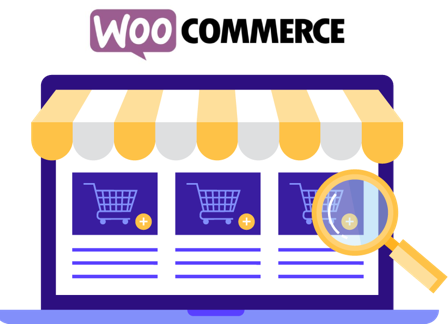
WordPress is Scalable
The design of your shop is the first thing that people will see when they visit your website so spending the time to get the right theme for your store can pay dividends in the long run.
In all likelihood, a free theme is unlikely to offer the best long-term value for your business. If you do choose a free theme, make sure it is supported and from a reputable source. Where possible, the best bet is likely to be a premium theme or even a custom WooCommerce theme.
Shared hosting has a number of pitfalls including:
- Is the theme being actively developed?
WordPress, the underlying CMS that powers any WooCommerce store is frequently updated. All WordPress themes (and in this instance a WooCommerce theme) will almost certainly need updates applied over the years in order to ensure that the theme remains compatible with the latest version of WordPress. As such, regular updates to your chosen theme are a must. - Is the theme fast to load?
Speed is a critical element to any WooCommerce store (so much so we have devoted an entire chapter to it). Whilst your hosting will play a key role in this speed, a well coded ‘clean’ WooCommerce theme will invariably load faster. Check this out using a speed test tool like Pingdom. - Is the WooCommerce theme mobile responsive?
With over 53% of traffic to websites now coming from mobiles, it’s vital your chosen theme works well on a mobile. Test this for yourself on your own phone before settling on a theme.
Great design can really help encourage people to shop on your site, especially if your site looks and functions better than the competitions. Your store design is the bedrock on which everything else grows so make sure it is as good as you can get it.
Optimizing for Usability

The usability of your site goes hand in hand with the design of your WooCommerce site. Unfortunately, there is a distinction between the two that is often ignored and this is costing eCommerce store owners $billions in lost revenue annually.
So, what is the difference between design and usability? Well, great design can mean different things to different people but it would be broadly accepted to state that design is focussed more on the aesthetic appeal of something, in this case a WooCommerce store. However, a store that looks absolutely jaw droppingly stunning isn’t necessarily one that is useable and there in lies a massive challenge for WooCommerce store owners.
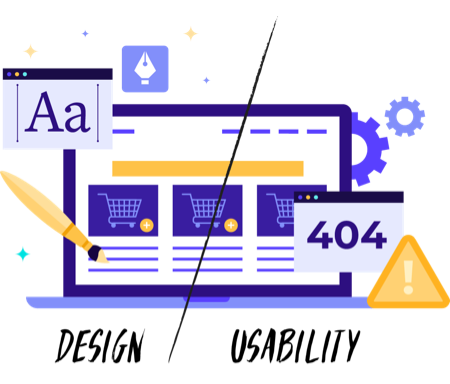
What is needed is a happy marriage between great design AND usability. If you can achieve this then you are a long way towards having a well-optimized WooCommerce store. So, what things can you look at from a usability perspective?
Making it easy to find products
People are on your site because they want to buy something. If you don’t make it easy for them to find what they want, quickly, then you’re going to lose a sale. It’s as simple as that. Any time spent ensuring that your products are as visible as possible is invaluable. Speed is important here… for example if you have to click on a menu, select a sub menu and then filter products on a page before finally arriving at a list of possible items, you could argue that this is going to take too long for your customer. People are a lot less patient than you might imagine so anything you can do with your product layout and navigation structure to allow them to access what they want with as few clicks as possible is going to be beneficial.

Ensuring all the information your buyer needs is to hand
For some reason, many eCommerce stores choose to bury important information on topics like Refunds and Deliveries on obscure, hard to find pages on their websites. For many buyers though, this is exactly the information they will want to check out before committing to a purchase so it’s vital you get this information in front of customers in an easy to read format.
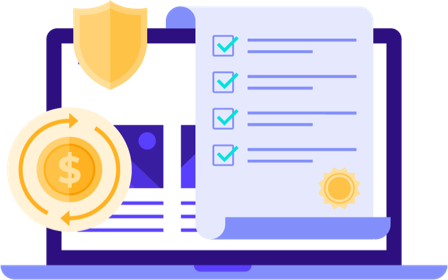
Not only that but the simpler and easier these terms of sale are the better. If you can offer free refunds then say so! If delivery charges can be kept at a low price or even free then so much the better. But whatever your terms, make it easy for people to find out and watch your sales rise as a result.
Make those CTA buttons stand out
CTA or Call to Action buttons shouldn’t just be on your site to look pretty. They should be carefully placed in a way that they help guide your customer through each and every stage of the buying process. The most important button is the ‘Add to cart’ button so make sure that really stands out. And then don’t forget to make it easy for people to proceed to the cart to complete their purchase. Buying something on a website is in many ways no different to buying something in a store. It’s all about the journey and easing your customers path from the shop door (your website homepage), past the products they want to the checkout in order that they complete the purchase.

The important thing with any eCommerce website is that you make life easy for the customer. If you can show them the products that they want, allay any buying fears (such as what you refund policy is), walk them to the checkout and make payment a swift process then you are heading towards a truly optimized WooCommerce store. So, what’s the bets way to make sure all your usability efforts are working as you imagine? Usability Testing.
Usability Testing
As the name suggests, usability testing is just that… testing your store to see how usable it is. It’s true for many projects, that when you’re up close and personal to it, it can be hard to see problems with, in this case, the design and layout of your website. Whilst of course it’s possible for you to try and take an objective and critical look at your own website, in reality, the fact that you will be very familiar with the layout can blind you to problems that would be immediately obvious to another user.

To get around this problem, you would be well advised to ask a group of people (preferably 4 or more) to try using your website. These testers should take detailed notes about their experience and should be able to alert you to any problems they have purchasing products on your site. For example, if they’re struggling to find the checkout button then you’ll know you need to make changes. Testing should be carried out regularly throughout the development of the site so you can remove these problems as you go. If you leave testing until the last minute you could find that wholesale changes are required which would be both prohibitively expensive and time consuming.
A/B Testing

Testers will also succumb to familiarity bias as well, so it’s a good idea to continually ask new people to test your site. Done correctly, you should end up with a website where you can be completely confident that your customers will be able to easily navigate around, find the products they want and purchase them with ease.
The level of careful optimization detailed in the section above might sound overkill but it can prove hugely profitable. It’s not uncommon for designers to find double digit percentage increases in sales after making really quite small alterations to the design and layout of sites. Trying to ascertain what changes increase sales though is best carried out methodically which brings us to a system known as A/B testing.
A/B testing or spit testing is a process whereby you experiment with two different designs/layouts on a page over a period of time in order to figure out which generates the most sales. A/B testing can be complex and it’s important to approach it in a methodical, organized way or you’ll end up with confusing results.
The best strategy to an optimized WooCommerce site is to begin with the initial design and build that is carefully tested by users throughout the build process as described above. By doing this you can be confident that there are no major roadblocks to people using and buying from your website. Having got a rock-solid foundation in place, A/B testing then allows you to move on to seeing how more nuanced, subtle changes might affect sales. A good example of A/B testing is changing the color of your CTA buttons. It has been shown that color’s can really affect click rates so it’s worth experimenting to find out what appeals to your customer base the most.
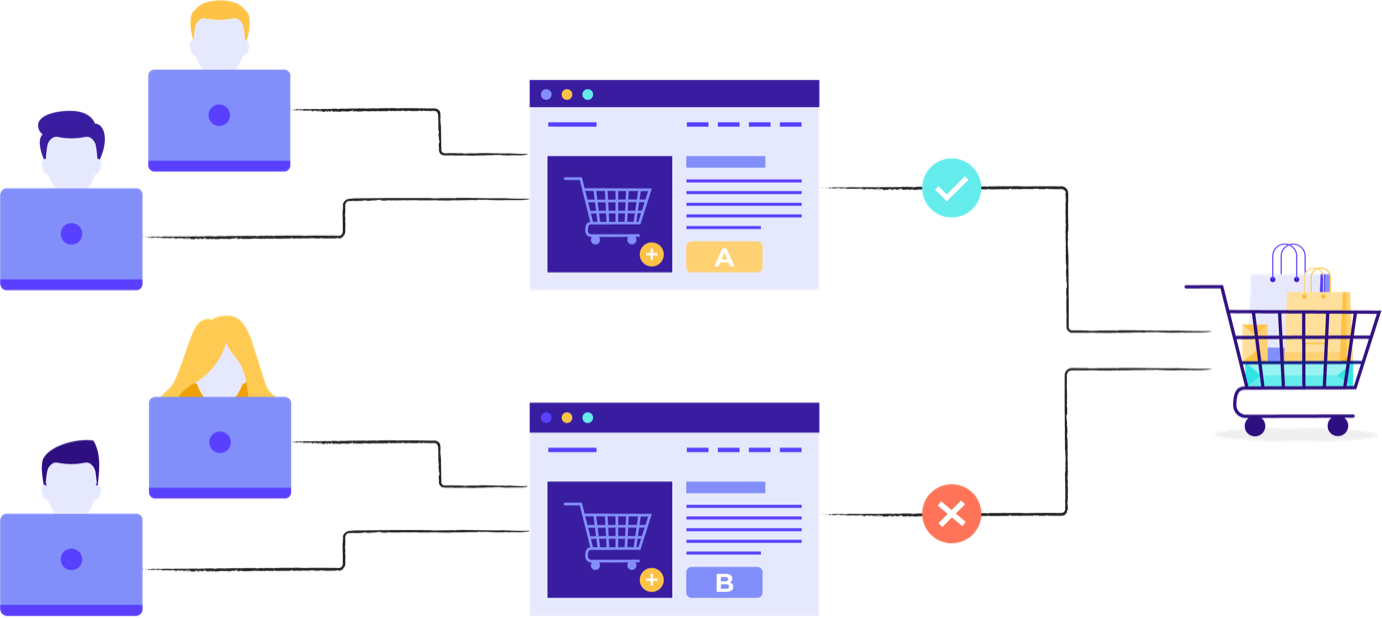
When A/B testing you need to be careful that you don’t introduce too many variables. If you were to change the color of a CTA button AND the text on that button it’s going to be hard to discern whether it was the color or text change that caused an uptick (or downtick) in sales or the text itself. So, first test the color and then test the text change separately.

There are various tools that can be used to help you A/B test including Google Optimize, Nelio A/B testing and Split Hero. In addition to A/B testing you might also want to consider using a tool like Hotjar. Hotjar allows you to see the areas that users on your website click. This data is converted into a ‘heat map’ that give you an immediate feel for how people are navigating around your site. Even better, Hotjar allows you to record users interactions with your website so you can watch them move through your site and in doing so spot any potential areas for improvement.
A/B testing is necessarily painstaking but focussing on this level of optimization is worthwhile if you’re serious about your WooCommerce store’s success.
Create High Quality Product Descriptions

As the old adage goes, ‘Content is King’. Not only will the written content on your site help persuade (or dissuade!) people to buy, but it will also play a significant role in your WooCommerce stores SEO. So, ensuring you have great written content is a must. For brochure type websites, content is often focussed on in more detail. When it comes to eCommerce websites, content can sometimes take a back seat. This is part can be due to the slightly daunting task of trying to come up with engaging descriptions for each and every product on your site. If you’re only selling a handful of items then it’s less of a problem. When ten becomes a thousand though, it’s understandable that the urge to just copy and paste a manufacturers description of a product can be strong. However you must resist the temptation!

For starters, Google will normally ignore sites that it finds that have duplicate content (and will only link to the site that originally published the content). When appearing as high as you can in the SERP’s should be a top priority, doing anything that could harm this is a no no. Secondly, descriptions can be a powerful motivator to buy. If you are giving people the same, generic description of a product that appears on other sites then where is the motivation to shop with you?
So, set aside some time to write great product descriptions. And if you have hundreds of products then start with the top sellers and work backwards. Your product description optimization efforts will almost certainly be rewarded with better SEO, increased sales and engagement with your store.
Other WooCommerce Optimization Hints & Tips

We’ve covered some of the core things you’ll need to do to better optimize your WooCommerce store for sales. We’ve left two important elements, Speed and Security for a separate chapter, but, these aside, here are some additional steps you could consider taking to boost your store’s takings.
Optimize your Store Checkout
Your store checkout is a critical element of your WooCommerce shop. It’s here that sales can be make or break and time spent optimizing this is essential.
Here are some key things to consider:
Do you require people to register at checkout?
Checking out of a store should be easy. Any barriers you throw up that disrupt what might be an impulse purchase could cost you sales. Whilst the temptation might be to force people to hand over a potential treasure trove of data, the more important thing should be focussing on closing the sale. In reality, the easier you can make this process the more you will sell. So, before you start asking for people to register or to provide their entire life history before letting them pass to the payment stage, consider what do you really need to know. Do you actually need their phone number for example? If not, don’t ask for it.
Making use of a tool like Hotjar can be invaluable in an area of your store like the checkout as this is where people will most likely have to interact the most with your store and as such presents the most opportunities for problems. Conversely, it’s the area that can provide the most opportunities for improvements so pay attention to it.

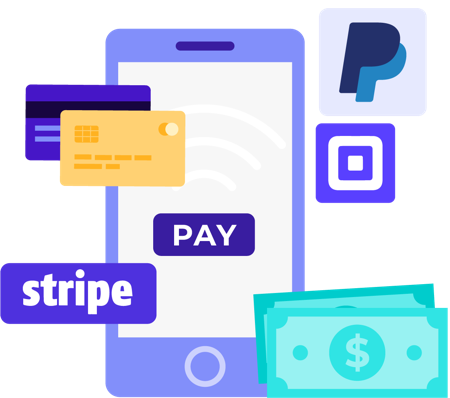
What payment methods do you accept?
WooCommerce integrates seamlessly with a large number of payment providers including PayPal, Stripe and Square. Although you don’t want to overwhelm your customers, the reality is that you want to offer as wide a range of payment options as possible. Credit and debit card payments are popular, as it the option to pay via PayPal so make sure these are on the list!
Use Live Chat
Live chat is an increasingly common way of communicating with customers. People are normally pretty reluctant to pick up the phone and live chat offers the immediacy of contact that is craved by today’s hyper connected consumer. Clearly live chat takes a degree of investment as you need to be able to staff it, ideally 24×7, so the cost of this will have to be factored it.


Provide Product Videos
Whilst great product descriptions are a must along with awesome photos, a video can be an amazing additional way of boosting sales. One of the key challenges faced by online retailers is getting people to feel like they understand your product and have experienced it. In the world of bricks and mortar retailers, people can handle a product and test it out. This element is missing online so the more you can do to give people a clear understanding of what your product is like the better.
Videos can serve two purposes. The first is to educate and the second is to help promote the business as a whole. Take a look at one of the most successful eCommerce videos of all time from Dollar Shave Club for inspiration.
CHAPTER four
The Importance of Speed, Reliability and ScalabilityCHAPTER four
The Importance of Speed, Reliability and Scalability
WooCommerce is suitable for pretty much all eCommerce businesses regardless of size. For large businesses looking to make the switch to WooCommerce, the speed and reliability of the platform are likely to be questions at the forefront of your team’s mind. You will also likely want to know how well a WooCommerce store will be able to handle the traffic your site is likely to receive.
For small businesses or ones just starting out on their eCommerce journey, speed, reliability and scalability are perhaps things that, at the moment anyway, seem of secondary importance. Understandably you are probably more focussed on launching, finding new customers and making some cash. We understand! It would however be a massive mistake whether your business is large or small to ignore the speed of your site, it’s reliability and critically, whether or not it can scale. Here’s why.
WooCommerce Speed

Website loading times have come under increasing scrutiny over the last couple of years, primarily as a result of the rise of mobile phone usage for web browsing. Whilst 4G (or even 5G in limited areas) offer some pretty impressive download speeds, for most of us we have to make do with 3G or worse. With download speeds of a couple of MB/sec or less, websites that are not optimized for speed will take a noticeable amount of time to load. And this is a problem.
Consumers today are impatient. Online shopping has made them more so. As such, even a few seconds delay on a website is enough to cause many to abandon their purchase and go elsewhere. And the worst bit? Not only has a slow website cost you a sale, but it might have cost you a customer for life. Kissmetrics compiled some statistics that estimated that a 1 second delay in page response can result in a 7% reduction in sales. That’s HUGE!

To further rub salt in the wound, a slow website will also cost you in terms of SEO rankings. Thanks to a page speed algorithm rolled out by Google in 2018, site load times are now a ranking signal.
Still not convinced? Let’s look at some official stats from Google at the probability of bounce rates depending on page load times.

Source: Google/SOASTA Research, 2017.
So how can you speed up your WooCommerce store? There are a several ‘easy wins’ on the path to lightning load speeds.
Use a high-quality web host
Perhaps the easiest way of ensuring your WooCommerce store loads quickly is by hosting it with a specialist WordPress host. WordPress is complex and ‘standard’ hosting that costs just a few dollars simply won’t cut it for many WooCommerce stores. Dedicated WordPress hosts have systems that are carefully designed to ensure (among many things) that your site loads quickly. From SSD storage, Multilayer Adaptive Caching, right through to SSL acceleration, there is a lot that can be achieved at server level to give your website the required boost in load times.
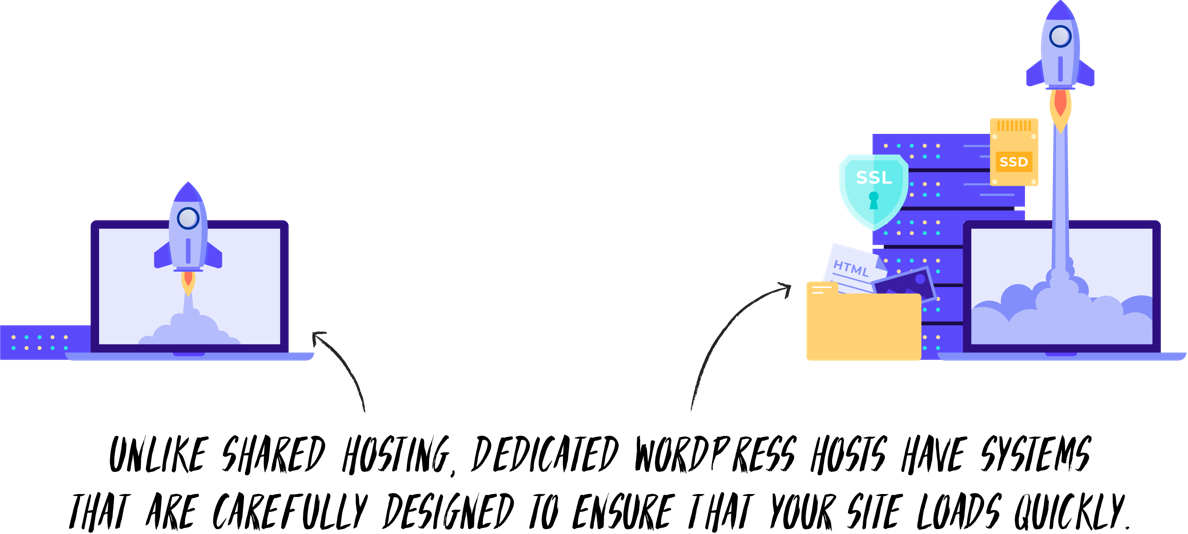
It’s important not to be fooled by the speed claims made by many hosts. It’s also vital that if you are testing loading times that you do so over the course of a couple of weeks and at different times of day. Cheap shared hosting can, on occasion, be blazingly fast… the problem is, due to the nature of shared hosting, that this speed will fluctuate wildly. One day you can see sub 2 second load times, but others you’ll be waiting for 10, 20 or more seconds for the exact same page to load. Inconsistent load times are a real no-no as it provides are hugely frustrating experience for your customer. High quality hosting should deliver consistent load times for your site regardless of site usage, time of day or server load.
It’s important to note that dedicated WordPress hosting is not a panacea for site speed issues. A poorly designed WooCommerce store will be slow regardless of host. None-the-less, high quality hosting provides the rock-solid foundations onto which a well-designed WooCommerce store can flourish.
Make sure image sizes are kept as small as possible.
When a customer loads your WooCommerce site, data is sent from the web server to their device (laptop, phone etc.). Depending on the speed of their connection, this data can be downloaded quickly… or slowly! With over 50% of all traffic coming from mobile devices, it’s important build your site so it can accommodate these mobile users. Whilst many of these mobile users may be on a wifi connection, you can’t make the assumption that everyone will be experiencing 30 or 40mbs download speeds. In fact, regardless of whether your customers are on a broadband or mobile network, download speeds around the world are typically pretty low.
To counter these low speeds one of the biggest things you can do on your WooCommerce website is make sure you optimize images to get their overall size as low as possible (we’re talking about file size, not dimensions here, although dimensions do impact file size). Clearly there is a fine line to tread… the lower the image size then, generally speaking, the lower the quality of the image. It’s counter productive to have a fast loading website only to put customers off with a grainy image. It is however possible to strike a happy balance.
There are two easy ways to reduce image sizes. First, check those dimensions. Images are normally measured in pixels. An image 5,000 pixels wide would be very large whilst one only 100 pixels wide would be pretty small. Typically, an image 1,000px wide would look good on most screens. By reducing the size of your images to around this level you will instantly reduce the overall file size.

The second thing you can do to reduce image size is to use an image compression tool. There are lots of these available and most do an amazing job of stripping out data that isn’t required in the image file whilst maintaining the same appearance to the naked eye. Both JPEGS & PNG files can become bloated (particularly PNG’s) and you can be amazed by how much image compression software can reduce these file sizes by. It’s not uncommon to see files of 1mb or more be reduced to around 100kb in size (that’s TEN TIMES smaller!).

And don’t forget that all of this data on a page adds up. You will almost certainly have a logo that appears on every page, perhaps a banner image, several product images and maybe image icons in the footer. Each of these has to be downloaded by the end user, your customer and they all add up. By optimizing each image on your site you can reduce the overall amount of data that has to be downloaded and in turn significantly speed up load times.
Website owners are spoilt for choice when it comes to image compression options. A popular site called TinyPNG allows you to upload images up to 5mb in size which are then compressed and made available for you to download. Their compression algorithm works really well but, if you already have a website with hundreds of images on it, it might not make sense to have to manually upload and then download and replace images in this way.
Instead you could use a WordPress plugin that compresses these directly on your site. TinyPNG also offer a plugin that does just this but you’ll have to pay for credits for each image you compress.
ShortPixel is another good quality option and also works by way of a plugin. Once the plugin is installed and you have purchased a subscription (about $10 a month for a massive 24,000 images at time of writing) the system will process all images on your site behind the scenes saving you a ton of time. When it’s finished, you’ll know that each image on your site is nicely optimized and in turn your page load speeds should increase.
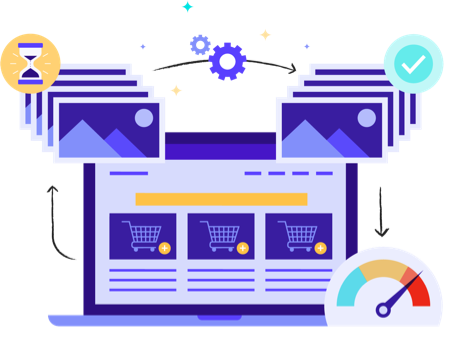
Use a Content Delivery Network (CDN)
The internet is a truly remarkable creation. At our fingertips are unprecedented levels of information that appear as if by magic at the click of a button. Even a slow website delivers this information pretty quickly in the grand scheme of things and it’s easy to forget that the data that is whizzed down a broadband line or through the air to your mobile actually originated in a server located somewhere in the world.
You have probably heard of server banks or server farms… basically these are (normally) large warehouse type facilities that are filled with rack after rack of servers. Servers are just stripped back computers and they contain all the data that ultimately goes to make up the web page that you receive on your computer or phone.
Very few of us will stop to consider that the server that sends us this data could be located thousands of miles away from where we are based. Pretty much everything happens on the internet so quickly that it just doesn’t occur to us to reflect that this data could have potentially travelled an incredible distance to get to us. But that is exactly what happens. And even in the world of the internet, distance does matter! All things being equal, if you are geographically located 5,000 miles from a server that is sending you data, this is going to add a couple of seconds to the time it takes for the web page you requested to load. In contrast, if the server that is sending you the data is just 50 miles from where you are standing, the data transmission will be close to instant.

So, what do you do to your website if your business is based in New York but your main customer base is on the West Coast in California some 3,000 miles away? Well there are a couple of options. The first is to choose a web host that has servers based in California. By hosting your website on these servers, it will literally be closer to your primary customer base and as such will impact the load times they experience when they visit your website.
But what do you do if you also have customers in New York… and Florida, and the UK? You use a CDN or Content Delivery Network. A CDN is a geographically distributed group of servers which work together to provide fast delivery of Internet content. It does this by placing exact copies of your website on a number of different servers (for example, one in San Francisco, one in New York, one in Tampa and one in London).
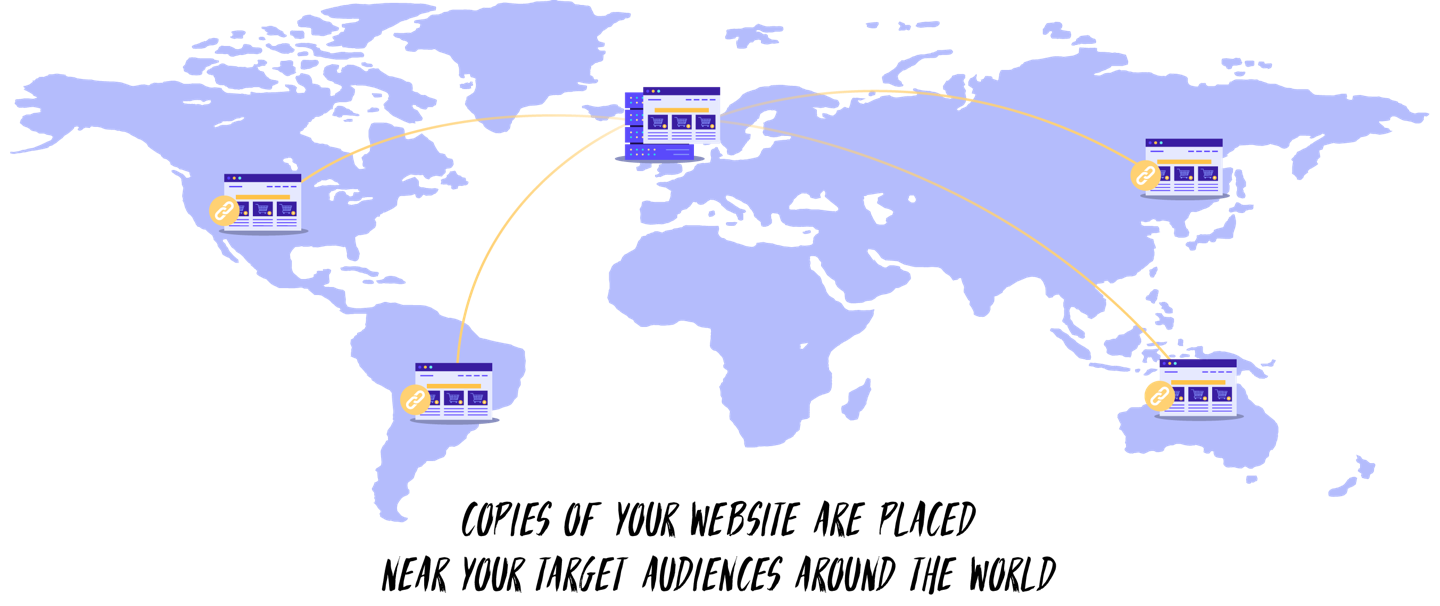
Depending on the location of the customer who then tries to access the website, the CDN directs them to the server that is physically located the closest to them. This can shave a significant amount of time off the load speed. In doing so your customer gets to enjoy a fast loading website which as we now know will significantly impact their perception of your business and the likelihood of a sale.
Testing Your Website Load Times

Before you get started working on speed optimizing your site it’s worth getting a benchmark reading to ascertain how quick (or otherwise) your site actually is. One of the best tools to do this is Pingdom’s Website Speed Test. It’s a free service that provides some great insights into how your page loads and which elements are taking the longest.
When you run a speed test, choose the geographical location nearest your customer base (which might be different from where your business is based). Run a speed test several times to ensure that you get a truly accurate representation of how your site is performing.
With this information in hand you’re able to focus your attention on the elements that are slowing things down. With these fixed you’ll hopefully end up with a blazingly fast WooCommerce store. Both Google and your Bank Balance will appreciate the effort!
WooCommerce Reliability and Scalability

One common question that is often asked by businesses looking to move their eCommerce operation to a WooCommerce site is ‘can WooCommerce Scale ok?’.
What is typically meant by this is ‘how many products can a WooCommerce store handle?’. It’s a valid question. According to Doug Aitken, a WooCommerce expert at Automattic (the company behind WordPress), WooCommerce can handle 1 million products. One would imagine this is more than enough for most businesses!
For many online shops however, the main challenge isn’t about finding a platform that can accommodate a large number of products or SKU’s but whether or not their site can handle thousands or tens of thousands of visitors. It is primarily in this context that the ability of your store to scale reliably that needs to be examined.
Peaks & Troughs – It’s all in the Traffic
Just like highway traffic, traffic to a WooCommerce store can vary depending on the time of day and the season. If you are selling to a local customer base then you’d be unlikely to experience peak shopping times at 3am. But you might find you get significant spikes at lunchtime when everyone takes the opportunity to indulge in some retail R&R.
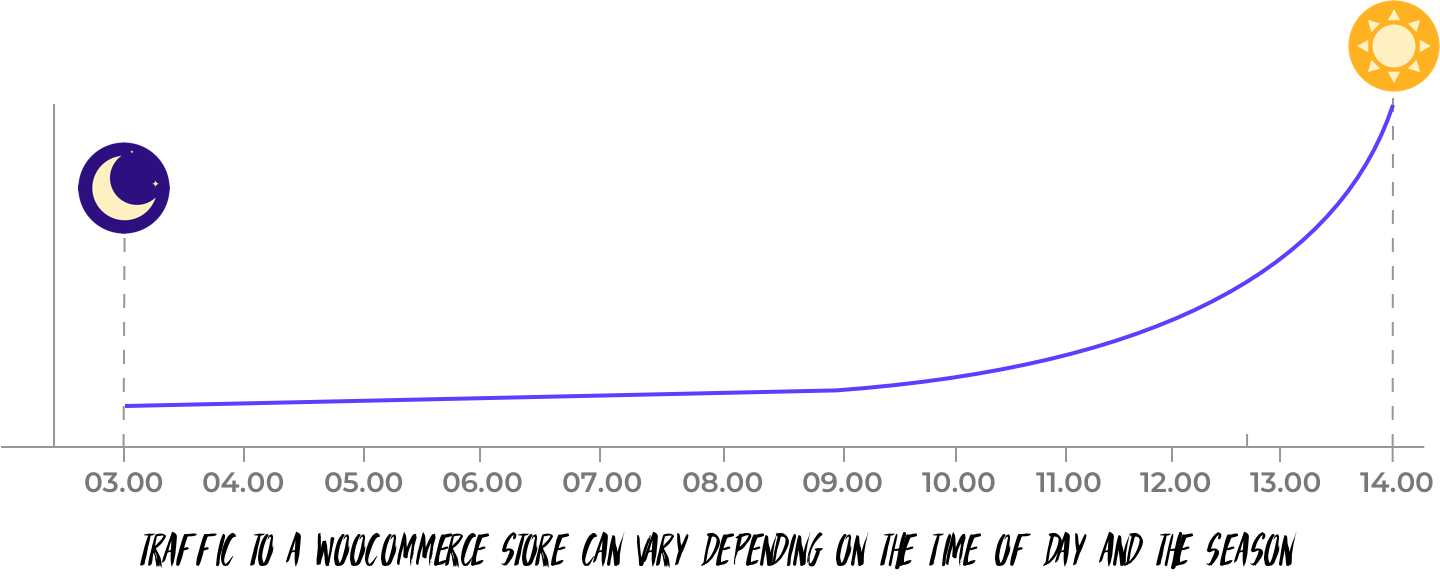
Because of this you could see 30% or more of your daily traffic hitting the site in just an hour or so. It is because of this that your WooCommerce store needs to be able to scale effectively.
Clearly, it’s going to be easier to manage to keep your WooCommerce store functioning properly when you only have a handful of visitors. But what happens when you have 500 customers all trying to checkout of your store concurrently? It’s precisely at these times when you really, really don’t want your website to crash! If it does you are causing maximum disappointment (in this example you’ve just seriously annoyed 500 customers!) and you are also going to experience maximum revenue loss (you’ve just lost 500 sales!).
These types of traffic spikes can occur at unpredictable times and, with traditional hosting setups (more on this in Part 5 and 6) they can be very hard to handle.
Seasonal events like Cyber Monday, Easter, Christmas and so on also can cause surges in traffic. Whilst these surges are perhaps more predictable, it is vitally important that your WooCommerce store can easily be ‘dialled up’ to cope.
In short, you need to ensure that your WooCommerce store is reliable and scalable (in terms of being able to handle traffic spikes easily).
So, how do you go about ensuring your store is reliable and scalable? Firstly, you need to make sure that your WooCommerce store is well engineered. A house built of wood won’t survive a hurricane… so, metaphorically speaking, you need to ensure your WooCommerce store is built out of reinforced concrete! This means running a reliable theme that is well coded and not relying on 100’s of plugins to provide required functionality for your site.
Secondly, you need to use the right hosting for your WooCommerce store. Hosting is the engine which drives your website and it’s critically important to ensure you use appropriate hosting if you want your store to operate reliably regardless of traffic variations and volume. With this in mind let’s move on and take a look at WooCommerce Hosting Options.
CHAPTER FIVE
WooCommerce Hosting OptionsCHAPTER FIVE
WooCommerce Hosting Options
eCommerce stores are by their very nature more complex than your average ‘brochure’ style website. There are a lot of moving parts including payment systems, shopping carts, account pages and so on. Throw in things like stock level updates and purchase and shipping email notifications and you begin to see why eCommerce stores can prove to be a real headache to run!
WooCommerce is an excellent eCommerce system but, perhaps unsurprisingly when you consider the functions it has to perform, is fairly resource intensive. As such, high quality hosting is an absolute must to ensure your WooCommerce store really delivers its full potential.
Let’s take a quick look at the hosting options available to you.
The most common form of website hosting available, Shared Hosting is the cheapest option available to website owners with hosting plans starting at just a few dollars a month from some providers.
In reality, ‘cheap and cheerful’ hosting will normally work just fine for a simple brochure website that has little traffic. For most WooCommerce stores though cheaper Shared Hosting just won’t pack enough punch. As with most things in life, you get what you pay for. If you want a fast loading, stable and reliable WooCommerce site then shared hosting will likely disappoint.

Shared Hosting Problems
Shared hosting has a number of pitfalls including:
- Slow Speeds
Because cheap hardware is used in shared hosting servers and the resources available are shared between customers your website(s) may load very slowly. - Security Vulnerabilities
Due to the shared nature of this hosting environment there is significant risk of ‘bleed through’ security issues as a result of malware or security vulnerabilities introduced to the server by other clients using the shared hosting platform. As such, no matter how good your websites are, they remain at risk courtesy of third parties on the server. - Support
Normally hundreds if not thousands of websites are crammed onto a shared server with all the pitfalls and problems outlined above. This is the only way that the hosting provider can make money thanks to the typically low price tag of a few $$ for shared hosting. This price tag has the result of also affecting the quality of support that you will receive from their tech team. Support is highly unlikely to be able to meet the demands placed on it by a business.
VPS WordPress Hosting
VPS stands for ‘Virtual Private Server’. VPS WordPress hosting is typically marketed as a premium WordPress hosting option and can be a viable option for WooCommerce hosting.
VPS Hosting works to reduce and/or eliminate some of the problems typically associated with shared hosting by compartmentalizing the server using programs which create a ‘virtual’ operating system on the server. Each server can run several virtualized operating systems. Clients who choose VPS Hosting are allocated their own virtualized operating system on a server from which their WordPress install(s) are run.

This virtualized operating environment means that you are able to run your own instances of PHP, Apache and MySQL as well as having a dedicated amount of RAM available to you.
Thanks to the way the system is virtualized it also enhances the level of security by reducing the risk of ‘bleed through’ from other clients, potentially malware infected files that reside on the server.
VPS Hosting is typically considered to be superior to shared hosting for the reason outlined above. The primary caveat is that of cost with VPS Hosting typically being significantly more expensive that shared hosting. Hosting providers will typically up their game when it comes to the level of support offered to VPS Hosting clients although this is not a given. VPS Hosting does offer a more ‘serious’ solution for WooCommerce hosting and is worth considering.
Dedicated WordPress Hosting
Dedicated WordPress Hosting could be described as the ‘Gold Standard’ for WordPress Hosting. As the name suggests, Dedicated Hosting is a term used to describe a web hosting package that provides a dedicated server for the sole use of the customer who rents it. This means that 100% of the server resources (RAM, CPU and Storage) are available to just you. And because only you have access to the server, this means that only your files (i.e. WordPress websites) should reside on it, reducing bleed through security risks to zero.
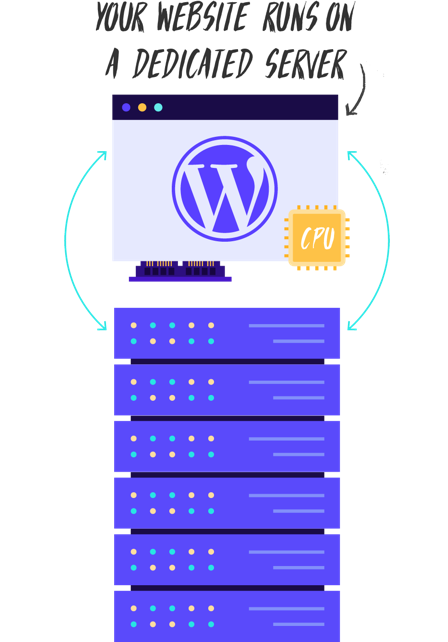
This can be a great choice for a busy WooCommerce store but does normally come at a steep price tag. In addition, you will probably want to pay for a maintenance package that covers server maintenance unless you’re clued up when it comes to how servers and the software that runs on them work.
Managed WordPress Hosting
Now we have looked at the three primary types of hosting available we need to take a look at a type of WordPress Hosting referred to as Managed WordPress Hosting.
WordPress is a pretty complex Content Management System (CMS) that benefits from hosting that is specifically designed for its unique requirements. This is particularly important for WooCommerce stores that, as discussed, have many more moving parts. Hosting solutions provided by Managed WordPress hosts will normally have been heavily optimized specifically for WordPress. This, in theory, means your WooCommerce store will run more quickly and will be less prone to security risks including hacking.
Managed WordPress hosts will also take care of server management as well as often providing automated WordPress core upgrades.
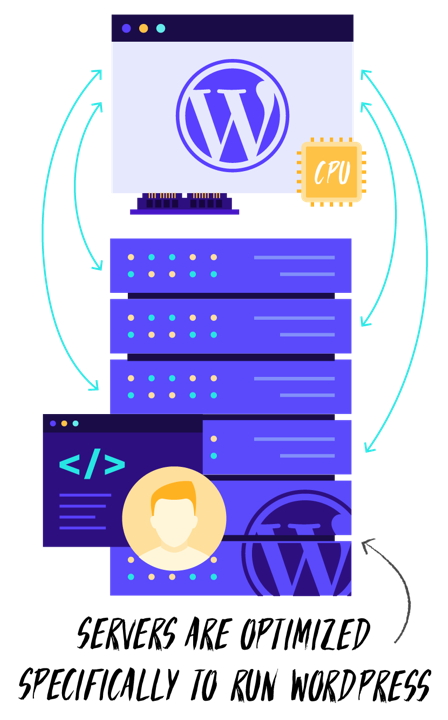
It’s important to note that whilst the phrase ‘managed WordPress Host’ is designed to convey the message that the hosting solution on offer is superior to the competition, this cannot be taken for granted.
Just as shared hosting can be good or bad, the same goes for managed hosting. Because WooCommerce stores have their own particular set of requirements, including the need for specific caching rules that take account of the difference between product pages and checkout pages, it’s worth hunting down a Managed WordPress host that specializes in WooCommerce hosting. Not only will their systems be better tailored to this kind of WordPress website, but their technical support team should also have more experience troubleshooting WooCommerce specific issues.
CHAPTER six
Features to look for in a Managed WordPress HostCHAPTER six
Features to look for in a Managed WordPress Host
For many businesses, using a high-quality Managed WordPress host offers the surest and easiest path to running a WordPress website that can scale with your business. To help you decide which host is likely to offer the best possible solution for your business WordPress hosting we have run through some key features that we feel are an absolute must-have for any managed WordPress hosting platform.
High Availability Architecture
Traditionally, most hosts use ‘ordinary’ servers located in server farms from which your website will be served. A server is simply a stripped-down version of a desktop computer and comprises of a hard drive, RAM and a CPU. As with a desktop computer, some servers are more powerful than others and this power (along with a number of other factors) will determine, in part, how easily (or not as the case may be!) that your website can handle high visitor numbers.
A crucial problem with standard hosting today however is that there is an overarching reliance on the one server that is hosting your website. If for some reason this server goes down (this might be caused by a hack, a server software bug, server overload or even hardware failure) then your website goes down with it. No ifs, not buts.
For many websites, a brief period of downtime isn’t the end of the world. As discussed in Chapter 4 however, Reliability and Scalability in a WooCommerce store is of critical importance.

Because downtime can be so ruinous for an eCommerce business, it’s important that a hosting solution is deployed that can ensure high levels of uptime and also that offers the scalability required by WooCommerce stores.
High levels of uptime can be achieved by using a High Availability hosting service. Hosting that utilizes a high availability setup doesn’t rely on a single server. Instead, High Availability platforms have a network of servers, each of which contain a copy of your website. Sophisticated monitoring software routes traffic to the least busy server and, in the event of a server failure, another picks up the job automatically. This means there is much less chance of website downtime.

Highly available systems are also able to handle large traffic spikes that might be caused by seasonal demand or an unexpected popularity of a product. Unlike a single server which is restrained by the CPU and RAM available to it, a high availability setup can distribute visitors across multiple servers at a moment’s notice meaning your business can enjoy the extra traffic without the headache of being notified your website has gone down.
Fantastic Technical Support
Website issues can be incredibly time consuming to deal with and, when you’re busy trying to run a business, are the last thing you want to be diverting your attention to. And, as with many things in life, you’ll find that technical issues can strike at the worst possible moment!
High quality technical support can offer a real lifeline at these critical times. Ideally you host of choice should offer you direct access to Tier 2 support agents 24/7, 365 days a year. Cheap hosting will almost certainly let you down in a number of ways, but particularly when it comes to support. And, to be fair, if you’re only paying a few dollars a year to host your website, it would be unreasonable to expect to get access to top level support engineers.

We think expert support is vital. No matter how good your host is, there will be times where you have a problem you need help with. It’s on these occasions where great support can really make all the difference. Your eCommerce business deserves the best so if you’re not getting the help you need, don’t be afraid to look at alternative hosting providers.
Helpful WordPress Management Tools
Whilst good quality, host provided technical support will be able to assist with a range of issues, the day-to-day management of your business website will still fall to you or your team. As such, any tools that can be used to help reduce the workload associated with this day-to-day management can be of significant value. There are several key tools that should ideally be provided by a WordPress host.
Backups
Backups are vital for any WordPress site. The ability to restore a site quickly and easily is invaluable. For example, if a plugin upgrade breaks a WordPress website a snapshot backup can be used to restore the site with just a couple of clicks. Without such a system you could be looking at hours and hours of work. Good backups allow you to enjoy the freedom that the Open Source WordPress platform provides by allowing you to move between hosts without fear. They are an absolute must have.
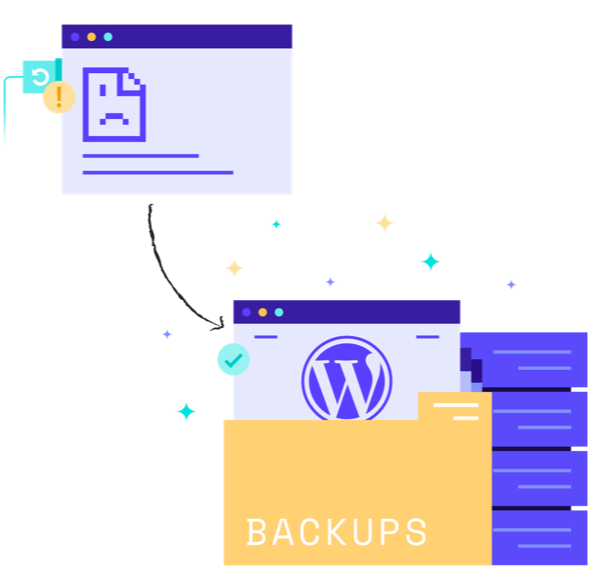
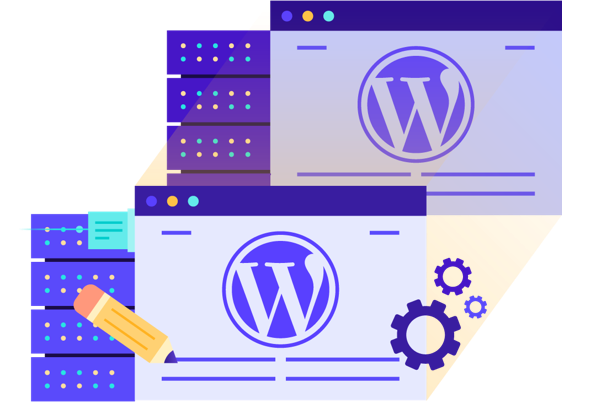
Staging Servers
A staging server is where you can work on a copy of a website without affecting the original, live website. This allows you or your team to make changes to a website (for example, adding new products), test plugins and so on without any downtime on the live site. When these changes have been satisfactorily made, they can be seamlessly pushed to the live site.
Dashboard
The third tool that is useful to have is a centralized dashboard where you can manage your website(s). A good dashboard will provide real-time stats on each website and allow things like plugins to be updated, backups exported and so on. This ‘command center’ ensures all of your WordPress assets are able to be easily managed.
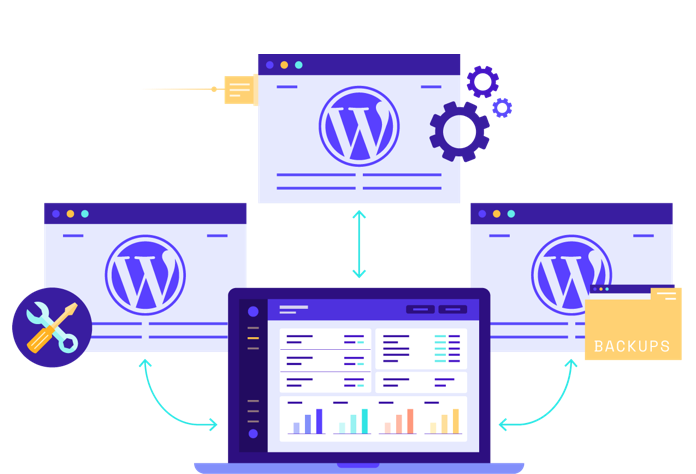
CHAPTER seven
In SummaryCHAPTER seven
In Summary
WooCommerce is a superb platform on which to build any eCommerce business. It offers an exceptional blend of power, customization and support and it’s suitable for both novice users as well as advanced developers.
Using WordPress as a foundation for your eCommerce store also brings a variety of benefits and the ability to move your store from host to host ensures you never have to endure vendor lock in (unlike with some other eCommerce systems like Shopify).
We hope this white paper has given you some insights into using WooCommerce as your eCommerce solution and the steps you can take to optimize it for sales. If you have any WordPress WooCommerce hosting related queries, our team would be only too happy to help.
CHAPTER eight
About PressidiumCHAPTER eight
About Pressidium

Pressidium is a technology company that builds powerful, secure and scalable infrastructure for businesses. Our fully managed Enterprise WordPress platform is trusted by Digital Agencies, Media Outlets, Tech startups and Fortune 500 companies. It is considered to be vastly superior to competing solutions on the market today.
From quality of service, workmanship and engineering, to sheer speed, security and site performance, our platform is built to deliver.
Join us and let your site thrive.





This white paper and its contents is copyright © Pressidium 2020. Pressidium® is a registered trademark of TechIO Limited. All rights reserved. All product names, logos, and brands mentioned in this white paper are property of their respective owners. All company, product and service names used in this website are for identification purposes only. Use of these names, logos, and brands does not imply endorsement.
Any redistribution or reproduction of part or all of the contents of this white paper in any form is prohibited other than the following:
- You may print or download to a local hard disk extracts for your personal and non-commercial use only.
- You may copy the content to individual third parties for their personal use, but only if you acknowledge pressidium.com as the source of the material.
You may not, except with our express written permission, distribute or commercially exploit the content. Nor may you transmit it or store it in any other website or other form of electronic retrieval system.







